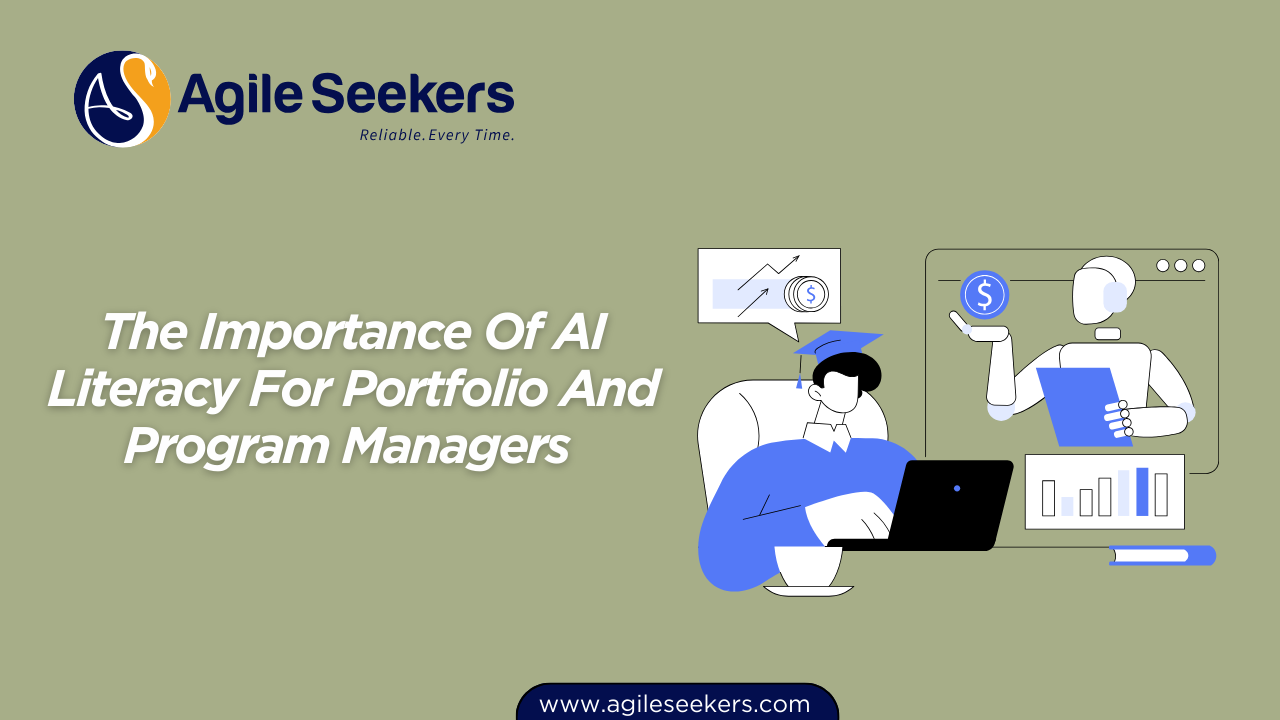The Importance Of AI Literacy For Portfolio And Program Managers

AI is no longer just a technology buzzword. It’s shaping decisions, influencing strategy, and transforming the way organizations deliver value. For portfolio and program managers, understanding how AI works—and more importantly, how to apply it—has become a leadership necessity rather than a technical bonus.
This post explores why AI literacy matters for portfolio and program managers, what skills they need, and how it impacts business outcomes.
Why AI Literacy Matters for Portfolio and Program Managers
-
Strategic Alignment with Business Goals
Portfolio and program managers are tasked with ensuring initiatives deliver on strategic objectives. AI offers data-driven insights that make alignment easier. With AI-powered tools, managers can track whether projects are delivering business value or drifting away from strategic intent. -
Better Decision-Making at Scale
Managing multiple programs means working with large volumes of data. AI literacy helps leaders move beyond intuition and use predictive analytics, machine learning models, and natural language processing to make informed choices. This reduces risks tied to bias and incomplete information. -
Bridging Business and Technology
Portfolio and program managers often sit between executive leadership and technical teams. A working knowledge of AI allows them to communicate more effectively with data scientists, product owners, and delivery teams. It eliminates confusion and helps leaders set realistic expectations about AI-driven outcomes.
The Core Skills of AI-Literate Leaders
-
Understanding AI Capabilities and Limits
Managers don’t need to code algorithms, but they must understand what AI can and cannot do. For example, machine learning can identify patterns in portfolio data, but it cannot replace human judgment when defining priorities or setting ethical boundaries. -
Data Interpretation and Insights
AI literacy includes the ability to interpret dashboards, metrics, and predictions. A manager who can read AI-driven portfolio reports will act faster on opportunities and risks. -
Ethical and Responsible AI Use
Program managers also need to evaluate bias, transparency, and fairness in AI applications. Without literacy in these areas, leaders risk adopting solutions that harm stakeholders or weaken trust. -
Scenario Planning with AI
AI supports scenario modeling—predicting potential outcomes of funding shifts, resource allocations, or delivery delays. Literacy in these techniques helps managers make proactive rather than reactive decisions.
How AI Impacts Portfolio and Program Outcomes
-
Improved Risk Management
AI-driven models can detect early warning signs across programs—missed dependencies, resource bottlenecks, or cost overruns. Managers who understand these signals can intervene before issues escalate. -
Optimized Resource Allocation
When managing multiple initiatives, prioritizing resources is always challenging. AI-powered tools help balance competing demands by predicting where resources will have the greatest impact. -
Enhanced Stakeholder Communication
AI tools can summarize large datasets into simple insights for stakeholders. Managers who know how to use these insights can create clarity and transparency in executive reporting. -
Continuous Improvement in Delivery
By analyzing flow metrics, cycle times, and customer outcomes, AI helps managers identify bottlenecks across portfolios. This directly supports continuous improvement, a key principle of Agile program delivery.
Why Portfolio and Program Managers Must Act Now
AI is advancing quickly, and organizations that wait too long to invest in literacy will fall behind. Early adopters already use AI to manage investments, predict delivery success, and support digital transformation. Waiting means risking competitive disadvantage.
For leaders managing large-scale Agile programs, AI is not optional—it’s a lever for scale, agility, and efficiency.
Pathways to Building AI Literacy
Portfolio and program managers don’t need to become data scientists, but they do need structured learning. Specialized training programs make it easier to apply AI concepts directly to leadership and delivery.
-
For leaders responsible for guiding transformations, the AI for Agile Leaders and Change Agents Certification helps them drive organizational adoption of AI responsibly.
-
Program and portfolio leaders can explore the AI for Project Managers Certification Training to build practical AI decision-making skills.
-
Product leaders should look into the AI for Product Owners Certification Training to connect AI-driven insights with product roadmaps and customer value.
-
Delivery-focused professionals can expand their skills with the AI for Scrum Masters Training, which equips them to manage team-level adoption of AI tools.
External Perspective: AI and Portfolio Management Trends
According to a recent report from the Project Management Institute (PMI), 81% of organizations say AI is already impacting their projects. Gartner also predicts that by 2030, 80% of project management tasks will be powered by AI. These insights highlight the urgency for leaders to embrace literacy and adapt their leadership style.
External resources such as Harvard Business Review and MIT Sloan Management Review also provide research-backed articles on the role of AI in leadership and strategy. Managers who continuously learn from these resources can stay ahead of industry shifts.
Practical Steps for Portfolio and Program Managers
-
Start with Awareness
Engage with AI tools your organization already uses—reporting dashboards, risk prediction systems, or customer analytics platforms. -
Invest in Training
Choose certification programs that balance technical understanding with leadership application. -
Apply AI Incrementally
Don’t wait for full-scale AI transformation. Start by using AI insights in reporting or decision-making, then expand into scenario planning and portfolio optimization. -
Measure Outcomes
Track the impact of AI-driven decisions on delivery speed, cost efficiency, and stakeholder satisfaction. This builds trust and justifies further investment.
Final Thoughts
AI literacy is not about mastering technology—it’s about enhancing leadership effectiveness. For portfolio and program managers, it’s the bridge between strategy and execution, helping them scale decisions, manage complexity, and deliver meaningful outcomes.
Organizations that encourage their leaders to develop AI skills will see stronger portfolio performance, improved stakeholder alignment, and sustained business agility.
Also read - AI Powered Insights For Business Leaders Driving Agility
Also see - Using AI To Improve Cross Functional Decision Making In Agile Enterprises




















